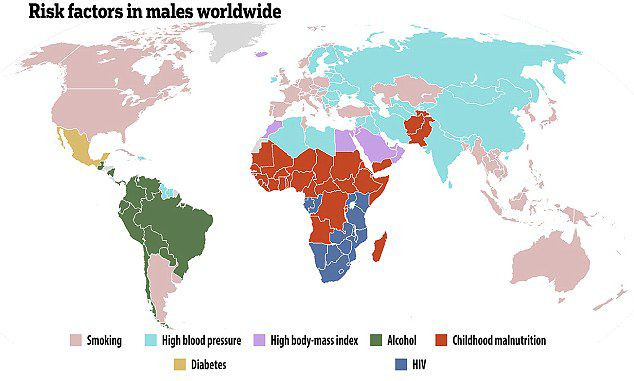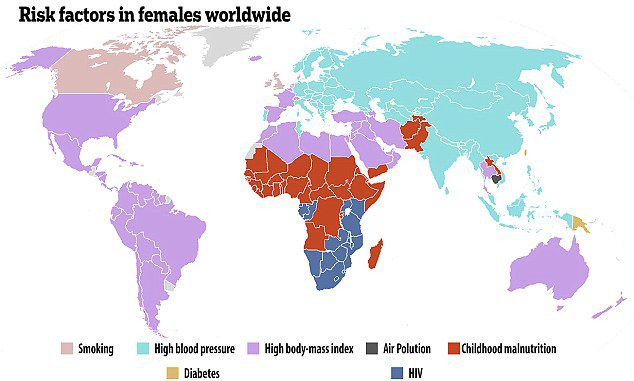1/5 of deaths in the world are due to red meat and soft drinks
Poor diet is the single biggest contributor to premature death worldwide.
Experts say 21% of global deaths can be attributed to diets high in red meat and sugary drinks, and low in fruit, vegetables and whole grains.
Unhealthy eating contributes to a large number of deaths because it leads to diseases such as heart disease, stroke and diabetes.
The leading risk factors associated with premature death in both men and women are high blood pressure, smoking, high body mass index (BMI) and high blood sugar, but the greatest cumulative impact on health comes from poor diet.
 |
| The map shows the biggest risk factors for premature death in men around the world. Overall, high blood pressure (blue) was the number 1 risk factor associated with global mortality in 2013, contributing to 10.4 million deaths risk, death, diet |
 |
| The map shows the biggest risk factors for premature death in women around the world. After high blood pressure (blue), high BMI (purple) is the second most important risk factor associated with death. |
Significant change in risk factors
The researchers looked at 14 dietary risk factors, including intake of fruits, vegetables, whole grains, nuts and seeds, dairy, processed meats, soft drinks, fiber, calcium, salt, seafood, and different types of fats.
Overall, high blood pressure is the leading risk factor associated with global mortality, contributing to 10.4 million deaths.
The impact of high blood pressure on mortality has increased by more than 49% since 1990, and this impact is more pronounced in men (59%) than in women (39.9%).
The Global Burden of Disease study is considered the most authoritative study of the causes of disease and premature death worldwide.
The study, led by the IHME and published in the Lancet, looked at 79 risks based on data from 108 countries, from 1990 to 2013.
The risk factors examined in the study contributed to a total of 30.8 million deaths in 2013, up a fifth from 25.1 million in 1990.
The composition of leading risk factors contributing to mortality has changed significantly since 1990.
Childhood malnutrition and unsafe water sources have dropped out of the top 10 risk factors, while high cholesterol and alcohol use have replaced them as major risk factors contributing to the disease.
Researchers also used a measure called disability-adjusted life years (DALYs) to measure health decline.
One DALY equals one healthy year of life lost and is calculated as the sum of years of life lost due to premature death and years of life lived with disability.
The top risk factors associated with the disease in 2013 were also risk factors for premature death: high blood pressure, smoking, and high BMI.
High blood pressure and smoking have increased since 1990, even though smoking rates have fallen in most countries, researchers say.
Risk factors also differ greatly between men and women.
Smoking is the biggest problem for men, ranked as the second leading cause and linked to 4.4 million deaths.
For women, smoking is the sixth leading risk factor, contributing to 1.4 million deaths.
Similarly, alcohol is the 10th leading risk factor for death in men, but is not among the top 10 risk factors for death in women.
Poor diet was responsible for 21% of deaths. These deaths can be attributed to diets high in red meat and sugary drinks, and low in fruits, vegetables and whole grains.
Children also face different risks than adults.
In children under 5 years of age, malnutrition – which includes underweight, dwarfism and wasting (having low weight for height, often due to hunger or disease) – is the leading cause of death.
Child malnutrition contributed to 1.3 million deaths in 2013, accounting for 21.1% of all deaths in children under 5 years of age.
Chad, South Sudan, the Democratic Republic of Congo, Somalia and Niger are the countries with the highest under-five mortality rates due to these risks.
Major regional differences
In many parts of the Middle East and Latin America, high BMI is the number one risk factor associated with disease.
In South and Southeast Asia, indoor air pollution is the top risk, while in India the top risks are unsafe water and child malnutrition.
Alcohol is the second-largest risk in Russia, while smoking is the number one risk in many high-income countries, including the UK.
The difference is most pronounced in sub-Saharan Africa, where, unlike other regions, a combination of childhood malnutrition, lack of clean water and sanitation, unsafe sex and alcohol use are the dominant risks.
Top 10 risk factors for premature death worldwide
The risk factors associated with the most premature deaths globally for both sexes in 2013 were:
1. High blood pressure
2. Smoking
3. High body mass index
4. High blood sugar
5. High salt diet
6. Eat less fruit
7. Air pollution
8. Indoor air pollution
9. High cholesterol
10. Alcohol
According to vietnamnet


